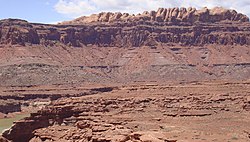Sinemur
Sinemur je časová jednotka v geologických vědách, označující geologický věk (chronologická jednotka) a stupeň (stratigrafická jednotka) v období spodní jury. K roku 2025 je toto období v dějinách planety Země datováno na 199,5 ± 0,3 – 192,9 ± 0,3 milionu let před současností.[1] Jedná se tedy o období dlouhé přibližně 6,6 milionu let, což odpovídá středně dlouhým věkům/stupním druhohorní éry. Tomuto druhému nejstaršímu jurskému stupni předchází stupeň hettang a následuje po něm stupeň pliensbach.[2]
Historie

Název sinemur definoval a zevedl roku 1842 francouzský paleontolog Alcide d'Orbigny.[3] Název vychází ze jména francouzské obce Semur-en-Auxois, nacházející se nedaleko Dijonu. Spodní hranicí (bází) tohoto období ve stratigrafickém pojetí je první výskyt amonitů rodu Vermiceras a Metophioceras.[4], svrchní hranicí pak první výskyt amonita druhu Bifericeras donovani a amonita rodu Apoderoceras. Globální referenční profil pro bázi tohoto období se nachází v obci East Quantoxhead, zhruba 6 kilometrů východně od obce Watchet v hrabství Somerset (jihozápadní Anglie).[5]
Fauna

Na souších byli v této době již zcela dominantní skupinou obratlovců dinosauři.[6] V Severní Americe patří k nejvýznamnějším formacím geologické souvrství Kayenta s dinosauřími rody Scelidosaurus[7], Scutellosaurus[8], Dilophosaurus, Kayentavenator nebo Sarahsaurus[9]. V Indii poskytuje dinosauří fosilie například souvrství (Svrchní) Dharmaram s fosilními nálezy vývojově primitivních sauropodomorfů rodů Lamplughsaura nebo Pradhania.[10] V Číně odpovídá tomuto geologickému stáří spodní část souvrství Lufeng, ze kterého známe například rody Bienosaurus, Tatisaurus, Eshanosaurus nebo Lukousaurus.[11] Dalším čínským souvrstvím, odpovídajícím tomuto období je C'-liou-ťing (angl. Ziliujing), z něhož známe například rody Archaeocursor, Gongxianosaurus, Qianlong, Sanpasaurus nebo Zizhongosaurus.[12] V Evropě je například souvrství Saltrio známé pro objevy mořských obratlovců (ryboještěři rodů Ichthyosaurus a Temnodontosaurus[13]), byl tu ale objeven také teropod rodu Saltriovenator[14]. V rámci jihoafrického souvrství Elliot byly z tohoto období objeveni například dinosauři rodů Lycorhinus, Abrictosaurus, Megapnosaurus nebo Pulanesaura.[15]
V této době byli již hojně diverzifikováni také pterosauři ("ptakoještěři"), například rody Rhamphinion nebo Dimorphodon.[16] Z početných mořských plazů (zejména plesiosaurů a ichtyosaurů) můžeme jmenovat rody Archaeonectrus, Thaumatodracon, Excalibosaurus nebo Leptonectes.[17]
Odkazy
Reference
- ↑ https://stratigraphy.org/chart
- ↑ International Commission on Stratigraphy (Chronostratigrafická tabulka, PDF). Prosinec 2024. (anglicky)
- ↑ d´Orbigny, A. (1842). Paléontologie française. 1. Terrains oolitiques ou jurassiques, 642 pp., Bertrand, Paris.
- ↑ Hillebrandt, A.v.; et al. (2013). The Global Stratotype Sections and Point (GSSP) for the base of the Jurassic System at Kuhjoch (Karwendel Mountains, Northern Calcareous Alps, Tyrol, Austria). Episodes. 36 (3): 162–198.
- ↑ Meister, C.; et al. (2006). The Global Boundary Stratotype Section and Point (GSSP) for the base of the Pliensbachian Stage (Lower Jurassic), Wine Haven, Yorkshire, UK. Episodes. 29 (2): 93–106.
- ↑ Schoepfer, S. D.; et al. (2022). The Triassic–Jurassic transition – A review of environmental change at the dawn of modern life. Earth-Science Reviews. 232: 104099.
- ↑ SOCHA, Vladimír. Pozdravme scelidosaura. OSEL.cz [online]. 3. září 2020. Dostupné online. (česky)
- ↑ https://dinosaurusblog.com/2015/11/16/nejmensi-znami-dinosauri/
- ↑ Rowe, T. B.; Sues, H.-D.; Reisz, R. R. (2011). Dispersal and diversity in the earliest North American sauropodomorph dinosaurs, with a description of a new taxon. Proceedings of the Royal Society B: Biological Sciences. 278 (1708): 1044–1053.
- ↑ Novas, F. E.; et al. (2010). New dinosaur species from the Upper Triassic Upper Maleri and Lower Dharmaram formations of central India. Earth and Environmental Science Transactions of the Royal Society of Edinburgh. 101 (3–4): 333–349.
- ↑ Barrett, P. M. (2009). The affinities of the enigmatic dinosaur Eshanosaurus deguchiianus from the Early Jurassic of Yunnan Province, People's Republic of China. Palaeontology. 52 (4): 681−688.
- ↑ Xi, Y.; et al. (2025). New evidence for the earliest ornithischian dinosaurs from Asia. iScience. 28 (1): 111641.
- ↑ Lindgren, J.; et al. (2025). Adaptations for stealth in the wing-like flippers of a large ichthyosaur. Nature.
- ↑ Dal Sasso; et al. (2018). The oldest ceratosaurian (Dinosauria: Theropoda), from the Lower Jurassic of Italy, sheds light on the evolution of the three-fingered hand of birds. PeerJ. 6 (e5976).
- ↑ McPhee, B. W.; et al. (2015). A new basal sauropod from the pre-Toarcian Jurassic of South Africa: evidence of niche-partitioning at the sauropodomorph–sauropod boundary?. Scientific Reports. 5: 13224.
- ↑ Bestwick, J.; et al. (2020). Dietary diversity and evolution of the earliest flying vertebrates revealed by dental microwear texture analysis. Nature Communications. 11 (1): 5293.
- ↑ Maisch, M. W.; Reisdorf, A. G. (2006). Evidence for the longest stratigraphic range of a post-Triassic Ichthyosaur: a Leptonectes tenuirostris from the Pliensbachian (Lower Jurassic) of Switzerland. Geobios. 39: 491-505.
Literatura
- Gradstein, F. M.; Ogg, J. G.; Smith, A. G. (2004). A Geologic Time Scale 2004. Cambridge University Press.
- Raven, T. J.; et al. (2019). A reassessment of the purported ankylosaurian dinosaur Bienosaurus lufengensis from the Lower Lufeng Formation of Yunnan, China. Acta Palaeontologica Polonica. 64 (2): 335–342.
Externí odkazy
- Informace na webu Stratigraphy (anglicky)
- Informace na webu Time Scale Foundation (anglicky)
- SOCHA, Vladimír. Nejbohatší geologická souvrství světa. OSEL.cz [online]. 12. března 2021. Dostupné online. (česky)

